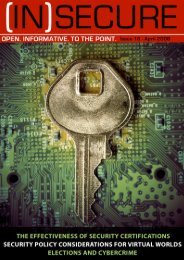download issue 24 here - Help Net Security
download issue 24 here - Help Net Security
download issue 24 here - Help Net Security
You also want an ePaper? Increase the reach of your titles
YUMPU automatically turns print PDFs into web optimized ePapers that Google loves.
used for the “key” to encrypt and decrypt data.<br />
Please do not let the terms “key,” “cipher” and<br />
“ciphertext” impede your understanding of encryption<br />
technology (we can do that with<br />
much more complex scenarios!). Just remember<br />
that TEXT follows a CIPHER (algorithm)<br />
using a KEY, creating CIPHERTEXT.<br />
Thatʼs it. For example, letʼs encrypt a phone<br />
number: (212)-755-<strong>24</strong>77. To encrypt this text<br />
we will use an algorithm w<strong>here</strong>by we very<br />
simply add a key to each digit. Thus, the algorithm<br />
is “digit+key” = “ciphertext.” The key we<br />
will use is arbitrary – letʼs say the number 5.<br />
T<strong>here</strong>fore, the ciphertext is (767)-200-7922.<br />
Notice that if the digit is greater than 10, we<br />
simply drop the “tens” place. This should be<br />
reflected in the definition of our algorithm BUT<br />
in an attempt to keep this simple we opted for<br />
understanding instead. In conclusion, to decrypt<br />
our ciphertext, the recipient must be<br />
given our encryption algorithm and key. The<br />
process can then be done in reverse - 7-5=2,<br />
6-5=1, etc. Of course, even DES, with its antiquated<br />
56-bit key, is MUCH MORE complicated<br />
than this example; but, hopefully, some<br />
insight has been offered that will aid the understanding<br />
of w<strong>here</strong> we are going with these<br />
ideas.<br />
DES, with a key that is 56-bits long, provides<br />
approximately seventy-two quadrillion iterations.<br />
Thatʼs 72 followed by 15 zeros. Although<br />
this may seem like an incredible<br />
number, as computing power continued to<br />
increase after 1977, the possibility of a computer<br />
with enough power to traverse all combinations<br />
being used also increased. It became<br />
clear that eventually, this would not<br />
suffice for all applications, especially those<br />
w<strong>here</strong> a breach would have grave repercussions.<br />
The DES algorithm and the mathematics of<br />
performing the DES operation more than once<br />
are linear. That means that if it takes x microseconds<br />
to encode a block using DES, with a<br />
56-bit key, it would take 3 times x to encode<br />
the same data by performing the DES algorithm<br />
with three distinct keys. Doing so provides<br />
an equivalent key of 56 x 3 or 168 bits.<br />
Not bad! However, we explain this process in<br />
this manner to clearly show that going from<br />
DES to 3DES requires three times the computing<br />
power to encode the same data. Re-<br />
member, EVERYTHING in IT is eventually<br />
guided by cost. So then, the question becomes,<br />
is 168 bits adequate to protect even<br />
the most sensitive of data?<br />
It only took 21 years for DES to be cracked<br />
using a brute force attack. In 1998, The Electronic<br />
Frontier Foundation utilized $250,000 of<br />
computing power to crack DES in less than<br />
three days. Since then, many successful attempts<br />
have been made in cracking DES. The<br />
point weʼre getting at is this: whether itʼs a<br />
single computer or many computers operating<br />
in parallel, the dollar value per computer cycle<br />
will vary; however, it is the number of keys<br />
that can be processed per second that matters.<br />
The computer in 1998 processed 88 billion<br />
keys per second. If we assume a 10-fold<br />
increase in computing power in ten years,<br />
then today, it would still take many hours to<br />
crack DES. NOW, given that, in comparison,<br />
using the same computer, with the 10-fold increase,<br />
it would take approximately 3 quadrillion<br />
years to crack 3DES. Thatʼs about<br />
250,000 times the age of the universe. Thus<br />
the odds, under current conditions, of cracking<br />
3DES are pretty slim.<br />
For basic understanding, 3DES uses a methodology<br />
known as “EDE” - encrypt, decrypt,<br />
encrypt. This means three different keys are<br />
used → [k1,k2,k3]. IF we simply encrypt 3x,<br />
using k1,k2, and k3, the effective key length<br />
would be only 58 bits, instead of the 168 with<br />
3DES-EDE.<br />
Now that we know all this, why should you<br />
ever want to introduce another algorithm? The<br />
short answer is - it depends. Letʼs consider<br />
w<strong>here</strong> AES (or the need for an alternative to<br />
3DES) became a consideration.<br />
The National Institute of Standards and Technology<br />
completed a task to find a replacement<br />
for Triple-DES. This endeavor was undertaken<br />
because of several factors. Obviously, as<br />
computer power continues to increase, the<br />
time it takes for a brute force attack against<br />
an algorithm to be successful would drop. Despite<br />
the times described above, which illustrate<br />
the improbability of this, another factor<br />
that could make a difference is computational<br />
complexity. What does this mean? In extremely<br />
simple terms, the algorithm cannot<br />
have any shortcuts that circumvent the<br />
www.insecuremag.com 53





